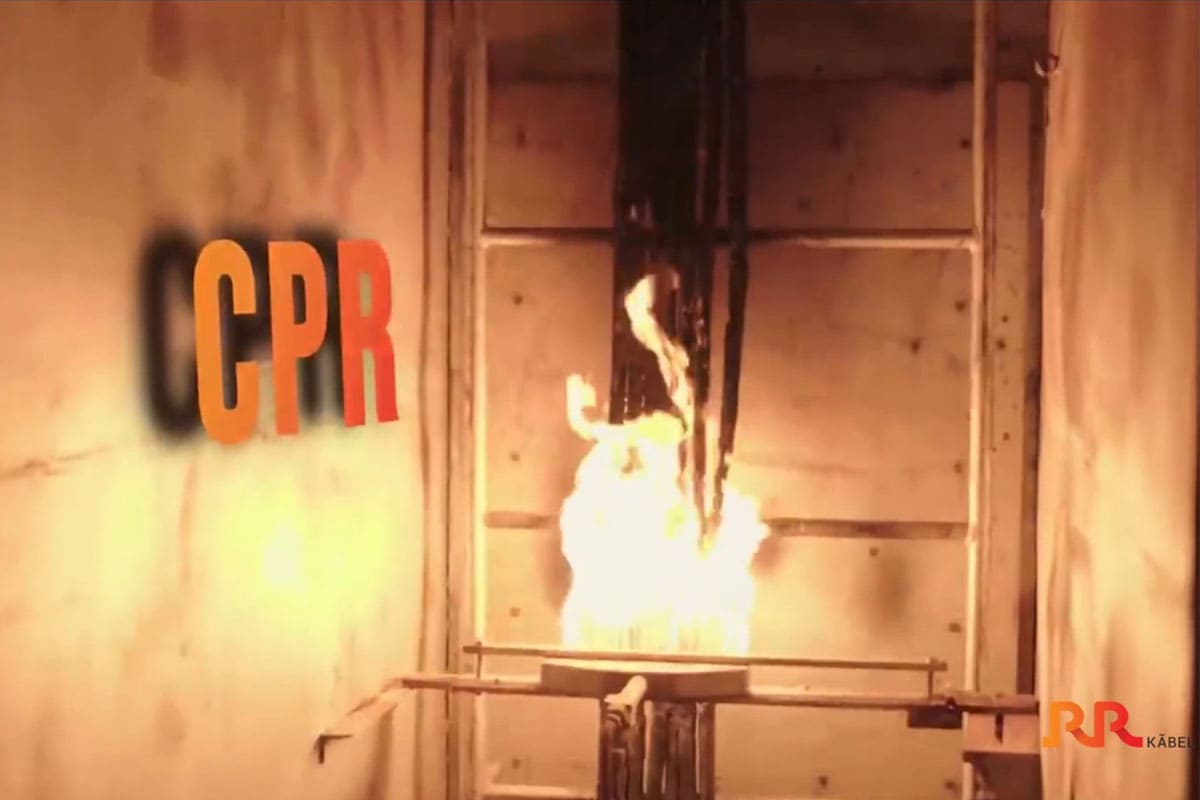Construction Product Regulation (CPR) for Wires and Cables

In a world where urbanization is accelerating and buildings are growing taller, denser, and more complex, fire safety has become a non-negotiable aspect of construction. One of the most effective regulations to emerge in recent years for improving building safety is the Construction Product Regulation (CPR), which is a European standard that classifies construction materials, including electrical cables, based on their reaction to fire.
What is CPR in wires and cables, and why is it important?
CPR provides a harmonized framework for evaluating and declaring the fire performance of construction materials, especially cables that are permanently installed in buildings and civil works. It defines how a cable behaves during a fire in terms of flame spread, heat release, smoke production, and toxic emissions - all of which are critical factors in safe evacuation and structural integrity. This classification helps project stakeholders select the right type of cable based on building risk and application.
Where is CPR-compliant cable used?
Originally mandated in the European Union, CPR-compliant cables are now increasingly specified in projects across the Middle East, Africa, and Asia, as many global markets adopt or align with EU fire safety standards. From hospitals and schools to airports, metros, offices, and high-rise residential complexes, CPR-rated cables are becoming the norm in projects that demand both performance transparency and life safety assurance.
Which Cables fall under CPR scope and how do they improve fire protection?
CPR applies to all power, control, and communication cables that are permanently installed in buildings and civil works - not just in the EU, but increasingly in global export markets that accept or require CE-marked products.
By choosing cables that meet specific CPR classes (like B2ca or Cca), architects, consultants, and contractors can ensure:
- Lower flame propagation
- Reduced smoke
- Minimal flaming droplets
- Lower toxicity
These are the factors that directly impact fire containment and evacuation time during emergencies.
What are the CPR Fire Performance Classes?
Cables under CPR are tested and categorized from Class Aca (highest performance) to Fca (lowest performance). The most commonly accepted classes for public and commercial buildings are B2ca, Cca, and Dca, depending on the risk level and local regulations. The following table summarizes the Euroclass classification system under CPR, outlining the performance criteria, additional safety parameters and attestation of conformity required for each class. This system helps stakeholders assess and compare the fire performance of cables used in buildings.
| Table 1: Euroclass Criteria | |||
| Euroclass (ca) | Classification Criteria | Additional Criteria | Attestation of conformity system |
| A | EN ISO 1716 Gross heat of combustion |
Initial type-testing and continuous surveillance with audit testing of samples by 3rd party certification body factory production control (FPC) by manufacturer |
|
| B1 | EN 50399 Heat release Flame spread. EN 50575 Flame propagation |
Smoke production* (s1a, s1b, s2, s3) EN50399/EN61034-2 Acidity (a1, a2, a3) EN 50267-2-3 Flaming droplets (d0, d1, d2) EN 50399 |
|
| B2 | |||
| C | |||
| D | Initial type testing by 3rd party laboratory FPC by manufacturer |
||
| E | EN 50575 Flame propagation |
||
| F | Initial type testing and FPC by manufacturer |
||
The table below breaks down the fire performance parameters like flame spread, heat release, smoke production, flaming droplets and acidity. These are used to classify cables from Aca to Fca. The additional parameters (s, d and a) give a more granular view of how the cable behaves in fire, helping specifiers and regulators choose the appropriate class for different applications.
| Table 2 – Fire Performance Classification | ||||||||
| Additional requiremen |
||||||||
| Flame | Aca | B1ca | B2ca | Cca | Dca | Eca | Fca | |
| Heat | Aca | B1ca | B2ca | Cca | Dca | Eca | Fca | |
| Smoke | s | s1a | s1b | s2 | ||||
| Droplet | d | d1 | d1 | d2 | ||||
| Acidity | a | a1 | a1 | a2 | ||||

For example, a cable rated Cca-s1a,d1,a1 means it has moderate flame spread, very low smoke generation, limited flaming droplets, and minimal acidity. Such compliance is ideal for enclosed public spaces like hospitals, airports, or schools.
What are CPR Test Requirements for Cables?
To achieve CPR classification, cables must pass a range of standardized fire performance tests, including:
- Heat of Combustion - This test is performed as per BS EN / ISO 1716, to measure the Calorific value of each cable component. It is only used for class Aca.
- Vertical Flame Spread - This test is performed as per EN 60332-1-2 to measure the flame propagation characteristics. This test is used for class B1ca, B2ca, Cca, Dca, Eca & Fca.
- Fire Performance Test - This test determines heat release, flame spread, smoke, and droplet production and is done as per EN 50399. This is generally used for class B1ca, B2ca, Cca and Dca.
- Smoke Density - This test is performed as per EN 61034-2 and measures light transmittance during combustion. Test is used for Classes B1ca, B2ca, Cca and Dca where applicable.
- Acid Gas Emission - This test evaluates acidity and conductivity of combustion gases and is performed as per BS EN 60754-2. This is used for Classes B1ca, B2ca, Cca and Dca.
These tests assess not just whether a cable burns, but how fast, how toxic the smoke is, and how much heat and flame it emits, which directly affects evacuation time during fires. It further ensures that only cables offering the desired fire performance levels are certified and CE marked under CPR.
Why is CPR Compliance Important Worldwide?
CPR compliance plays a critical role in enhancing fire safety in modern infrastructure, particularly in high occupancy or sensitive environments like airports, hospitals, schools, data centers, and residential complexes. It ensures cables are tested not only for flame spread but for all key factors in fire related fatalities. As global safety standards tighten, CPR rated cables offer a unified, transparent way to assess fire performance and support safer building practices.
For international customers, CPR compliance also adds transparency and comparability to cable performance. By aligning with uniform classification systems, stakeholders can better evaluate and specify the appropriate class of cable based on building type, fire load, evacuation strategy, and national regulations.
How do Manufacturers and Testing Bodies ensure CPR Compliance?
Manufacturers play a crucial role in ensuring that cables comply with CPR requirements. This includes selecting appropriate raw materials, adhering to precise construction standards, and subjecting their products to rigorous third-party testing. CPR compliance demands a Declaration of Performance (DoP) for each product, which clearly states the cable’s fire performance class and associated characteristics. These declarations must be supported by testing conducted at accredited notified laboratories to ensure consistency and impartiality.
Who is affected by CPR?
CPR is not just a manufacturing obligation rather it impacts multiple stakeholders across each layer of the supply chain as summarized below:
- Consultants / Specifiers : Must define minimum CPR class in project designs based on building risk profile.
- Contractors / Installers : Are responsible for using cables that meet the specified CPR class.
- Distributors : Need to ensure that cables in inventory comply with project and regional CPR requirements.
- End Users / Facility Owners : Should demand CPR compliance to ensure long-term fire safety in their buildings.
Conclusion
Beyond meeting regulatory mandates, CPR compliance reflects a deeper commitment to safety, sustainability, and accountability in the built environment. It empowers stakeholders, from architects and specifiers to installers and facility owners to make informed decisions that prioritize human life and structural resilience. In an era where fire-related risks are under greater scrutiny, selecting CPR-compliant cables is not just a technical choice, but a moral one. As global infrastructure continues to expand and evolve, embracing CPR-rated cables is a step toward harmonizing safety standards across regions and future-proofing construction practices for generations to come.

